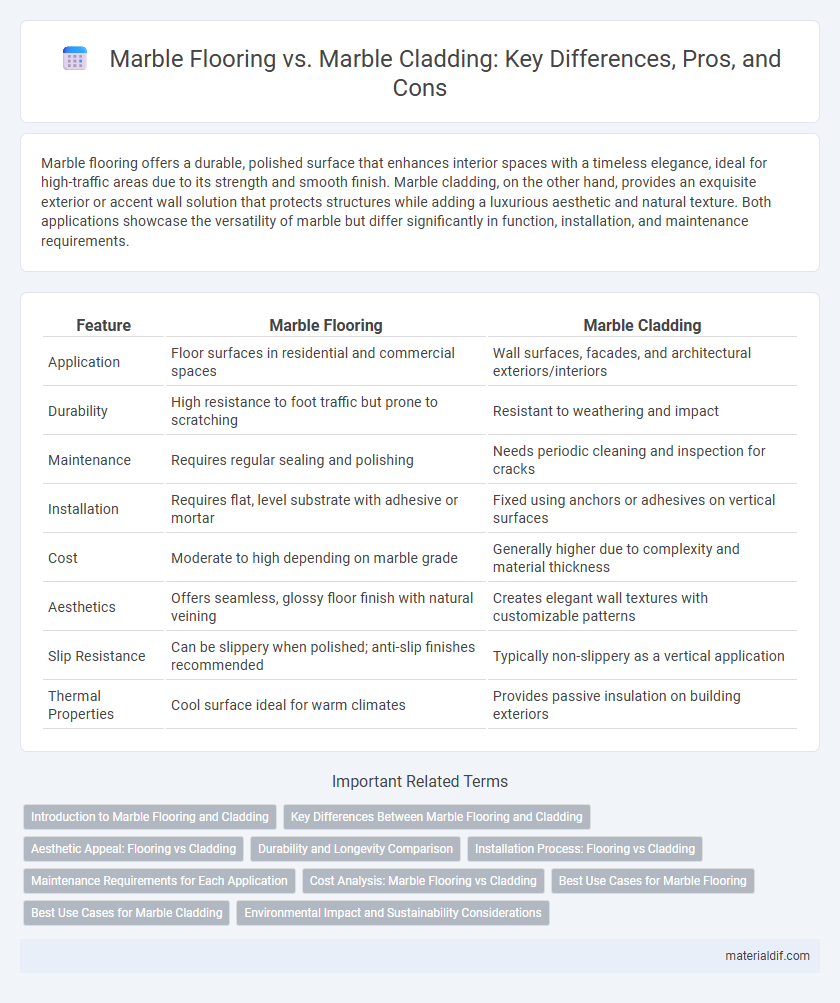Marble flooring offers a durable, polished surface that enhances interior spaces with a timeless elegance, ideal for high-traffic areas due to its strength and smooth finish. Marble cladding, on the other hand, provides an exquisite exterior or accent wall solution that protects structures while adding a luxurious aesthetic and natural texture. Both applications showcase the versatility of marble but differ significantly in function, installation, and maintenance requirements.
Table of Comparison
| Feature | Marble Flooring | Marble Cladding |
|---|---|---|
| Application | Floor surfaces in residential and commercial spaces | Wall surfaces, facades, and architectural exteriors/interiors |
| Durability | High resistance to foot traffic but prone to scratching | Resistant to weathering and impact |
| Maintenance | Requires regular sealing and polishing | Needs periodic cleaning and inspection for cracks |
| Installation | Requires flat, level substrate with adhesive or mortar | Fixed using anchors or adhesives on vertical surfaces |
| Cost | Moderate to high depending on marble grade | Generally higher due to complexity and material thickness |
| Aesthetics | Offers seamless, glossy floor finish with natural veining | Creates elegant wall textures with customizable patterns |
| Slip Resistance | Can be slippery when polished; anti-slip finishes recommended | Typically non-slippery as a vertical application |
| Thermal Properties | Cool surface ideal for warm climates | Provides passive insulation on building exteriors |
Introduction to Marble Flooring and Cladding
Marble flooring offers a durable, elegant surface ideal for high-traffic areas, enhancing indoor aesthetics with natural veining and a polished finish. Marble cladding involves covering walls or exterior surfaces, providing protection against weather while adding sophisticated texture and depth to building facades. Both applications utilize marble's unique strength and beauty but serve distinct architectural functions in interior and exterior design.
Key Differences Between Marble Flooring and Cladding
Marble flooring involves installing polished marble slabs on floors to provide a durable, elegant surface that withstands foot traffic, while marble cladding refers to applying thin marble panels to walls or facades for aesthetic enhancement and protection. The key differences lie in the thickness and treatment of marble, with flooring requiring thicker, more wear-resistant slabs and cladding using thinner, lighter panels optimized for vertical surfaces. Additionally, flooring demands slip-resistant finishes and higher structural support, whereas cladding prioritizes seamless installation and weather resistance for exterior applications.
Aesthetic Appeal: Flooring vs Cladding
Marble flooring offers a seamless, elegant surface that enhances interior spaces with natural veining patterns visible underfoot, creating a luxurious ambiance. Marble cladding transforms walls and exteriors by providing textured, dimensional aesthetics that emphasize architectural features and offer visual depth. Both applications showcase marble's timeless beauty, but flooring prioritizes smooth, continuous surface appeal while cladding highlights sculptural and layered visual impact.
Durability and Longevity Comparison
Marble flooring offers superior durability for high-traffic areas due to its thickness and ability to withstand heavy footfall without significant wear. Marble cladding, while providing excellent weather resistance and aesthetic appeal on exterior walls, may be more susceptible to surface etching and environmental damage over time. The longevity of marble flooring typically exceeds that of cladding, as it endures mechanical stress better and maintains structural integrity through proper maintenance.
Installation Process: Flooring vs Cladding
Marble flooring installation involves precise subfloor preparation, leveling, and the use of strong adhesives or thin-set mortar to ensure durability and seamless tile placement. Marble cladding requires secure anchoring systems or mechanical fixings to attach slabs vertically to walls, demanding special attention to weight distribution and weatherproof sealing. Both processes necessitate skilled labor, but flooring prioritizes load-bearing stability, while cladding focuses on structural support and long-term facade adhesion.
Maintenance Requirements for Each Application
Marble flooring requires regular sealing and polishing to prevent stains and wear from foot traffic, ensuring longevity and a pristine appearance. Marble cladding demands less frequent maintenance but still needs periodic cleaning and resealing to protect against weathering and discoloration, especially in exterior applications. Both applications benefit from immediate spill cleanup and use of pH-neutral cleaners to preserve the stone's natural beauty.
Cost Analysis: Marble Flooring vs Cladding
Marble flooring typically incurs higher installation costs due to the need for durable subfloor preparation and precise cutting to fit foot traffic areas, with prices ranging from $12 to $30 per square foot. Marble cladding, used primarily for walls and facades, generally costs less in installation, averaging $7 to $20 per square foot, but may require additional structural support based on wall type. Maintenance expenses tend to be similar for both, involving regular sealing and cleaning to preserve the marble's appearance and prevent damage.
Best Use Cases for Marble Flooring
Marble flooring excels in high-traffic indoor areas such as living rooms, foyers, and hallways due to its durability, aesthetic appeal, and ease of maintenance. Its polished surface enhances natural light reflection, creating a luxurious ambiance suitable for residential and commercial spaces alike. Best used in environments where elegance and longevity are prioritized, marble flooring also benefits from proper sealing to prevent stains and maintain its pristine appearance over time.
Best Use Cases for Marble Cladding
Marble cladding is ideal for exterior facades and interior accent walls, providing durability against weather and enhancing architectural elegance. Its versatility in thickness and finish makes it suitable for vertical applications where visual impact and protection are key. Compared to marble flooring, cladding offers superior resistance to wear and staining, making it perfect for high-traffic or exposed areas.
Environmental Impact and Sustainability Considerations
Marble flooring requires extensive quarrying and processing, leading to higher energy consumption and carbon emissions compared to marble cladding, which uses thinner slabs and less material. Marble cladding promotes sustainability by reducing raw material extraction and allowing for efficient thermal insulation, lowering energy usage in buildings. Both applications benefit from the natural durability and recyclability of marble, but cladding offers a more environmentally friendly solution through resource optimization and improved building performance.
Marble Flooring vs Marble Cladding Infographic

 materialdif.com
materialdif.com